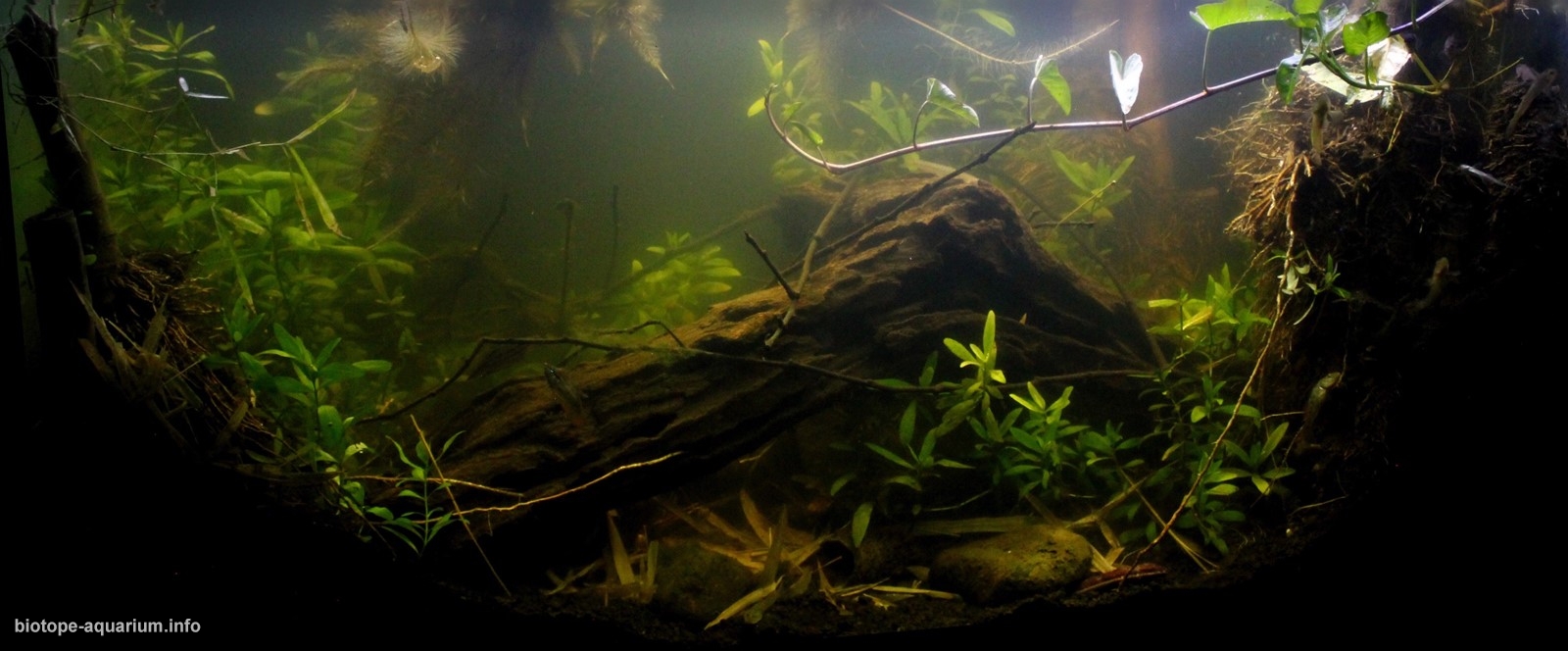Small Pond System, Downstream of Brantas River Delta, East Java Province, Indonesia
_th place in Biotope Aquarium Design Contest 2020

Volume: 194L
Dimensions: 100 x 40 x 40
List of fishes: Macrognathus Aculeatus, Trichopsis Vittata, Glyptothorax Platypogon, Nemacheilus Fasciatus, Palaemonetes, Rhinogobius, Pila Ampullacea.
List of plants: Hygrophila Polysperma, Ipomoea aquatica, Lemnoideae, Bambuseae, Pistia stratiotes.
Description of decorations: the material used in this aquarium is collected directly from the margins of the Brantas river delta such as rocks, sand, wood, plants, fish, along with the water source. the purpose of collecting raw materialsto make a copy of the underwater river brantas river delta ecosystem to resemble the design and ecosystem of the river.
Description of equipment: water filtration using DIY amara filter canister 1500L / h with biological media. assisted by amara 1000L / h for the effects of heavy current. while the lighting used is 70 watts led 6500k smd strip
Water parameters: Temperature is 28-29°C, pH is 6.4-6.8, GH:6, TDS:9
Additional info: In my aquarium, I used a lot of drifting trees, branches and dead leaves to simulate the accumulation of trees and branches along the beach and river bank, and a lot of light background color to simulate the beach color of habitat. I used one external filters and one pre-filters for both physical filtration and nitrifying bacteria cultivation. I use pure water and a small amount of domestic water to mix to ensure the balance of GH/TDS values, because there are a lot of driftwood, plants and dead leaves in the tank, they can control the fluctuation of PH values very well. It’s easy for me to control algae growth by changing water and controlling light time. In daily maintenance, only changing water and cleaning the glass of fish tank.
INFORMATION ABOUT BIOTOPE:
Description of the area surrounding the biotope: The Brantas is the longest river in East Java, Indonesia. It has a length of 320 km, and drains an area over 11,000 km² from the southern slope of Mount Kawi-Kelud-Butak, Mount Wilis, and the northern slopes of Mount Liman-Limas, Mount Welirang, and Mount Anjasmoro. Its course is semi-circular or spiral in shape: at its source the river heads southeast, but gradually curves south, then southwest, then west, then north, and finally it flows generally eastward at the point where it branches off to become the Kalimas and Porong River. The river flows in the eastern area of Java with predominantly tropical monsoon climate (designated as Am in the Köppen-Geiger climate classification). The annual average temperature in the area is 26 °C. The warmest month is October, when the average temperature is around 30 °C, and the coldest is June, at 24 °C. The average annual rainfall is 2982 mm. The wettest month is March, with an average of 496 mm rainfall, and the driest is August, with 28 mm rainfall. Fishes in the nature biotope Macrognathus Aculeatus, Trichopsis Vittata, Glyptothorax Platypogon, Nemacheilus Fasciatus, Palaemonetes, Rhinogobius, Pila Ampullacea, Mastacembalus unicolor, Mystus, Hemibagrus, Channa Striata, Trichopodus trichopterus, Anabas testudineus, Puntius Binotatus, rasbora argyrotaenia,claris batracus, osteachilus vittatus,puntius, barbodes ballerides, hampala macrolrpidota,tor soro,osphronemus gouramy, pangasius micronemus, hemibagrus nemurus, tor tombroides. But this time I only raise the topic of biotope in the Brantas River delta, which is a shallower location and is inhabited by various types of small fish and plants.
rocks, sand, wood, plants.
Description of the underwater landscape of the biotope: sandy and rocky substrate, there are many branches and driftwood in the water,
there are lots of plants in the delta.
Description of the parameters of the habitat: The river flows in the eastern area of Java with predominantly tropical monsoon climate (designated as Am in the Köppen-Geiger climate classification). The annual average temperature in the area is 26 °C. The warmest month is October, when the average temperature is around 30 °C, and the coldest is June, at 24 °C. The average annual rainfall is 2982 mm. The wettest month is March, with an average of 496 mm rainfall, and the driest is August, with 28 mm rainfall. pH is 6.9-7.2
List of fishes and invertebrates occurring in the nature biotope: Macrognathus Aculeatus, Trichopsis Vittata, Glyptothorax Platypogon, Nemacheilus Fasciatus, Palaemonetes, Rhinogobius, Pila Ampullacea, Mastacembalus unicolor, Mystus, Hemibagrus, Channa Striata, Trichopodus trichopterus, Anabas testudineus, Puntius Binotatus, rasbora argyrotaenia,claris batracus, osteachilus vittatus,puntius, barbodes ballerides, hampala macrolrpidota,tor soro,osphronemus gouramy, pangasius micronemus, hemibagrus nemurus, tor tombroides.
List of plants found in the nature biotope: Hygrophila Polysperma, Ipomoea aquatica, Lemnoideae, Bambuseae, Pistia stratiotes, Ceratophyllum.
Threats to the ecology: The aquarium was set up to attract public attention to the problem of endangered species of hydrobionts and the ecology of water bodies. Capturing more and more natural areas, human pollute the habitat, thereby displacing fishes, leading them to extinction. The example is Jambal fish, Lempuk Fish, Ulo fish, who formerly inhabited the waters of the Brantas River, East Java, Indonesia. People who settled nearby polluted the waters of the river, washed clothes in it, drained the dirty waters, cattle grazed alongside. And now there is no Jambal fish, Lempuk Fish, Ulo fish in the Brantas river. One more representative of the goodeids is under threat of extinction: Remes fish, who lived in the same river.
Sources of information:
article : Kali Brantas at Geonames.org (cc-by); Last updated 2013-06-04; Database dump downloaded 2015-11-27
Whitten, T; Soeriaatmadja, R. E.; Suraya A. A. (1996). The Ecology of Java and Bali. Hong Kong: Periplus Editions Ltd. hlm. 132.
Ramu, Kikkeri (December 2004). “Brantas River Basin Case Study, Indonesia” (pdf). Background Paper. Worldbank: 36.
Peel, M C; Finlayson, B L; McMahon, T A (2007). “Updated world map of the Köppen-Geiger climate classification”. Hydrology and Earth System Sciences. 11: 1633–1644. doi:10.5194/hess-11-1633-2007. Diakses tanggal 30 January 2016.
“NASA Earth Observations Data Set Index”. NASA. 30 January 2016.
“NASA Earth Observations: Rainfall (1 month – TRMM)”. NASA/Tropical Rainfall Monitoring Mission. 30 January 2016.
sources : http://bkipm.kkp.go.id/
https://dkp.jatimprov.go.id/
http://news.unair.ac.id/2019/
